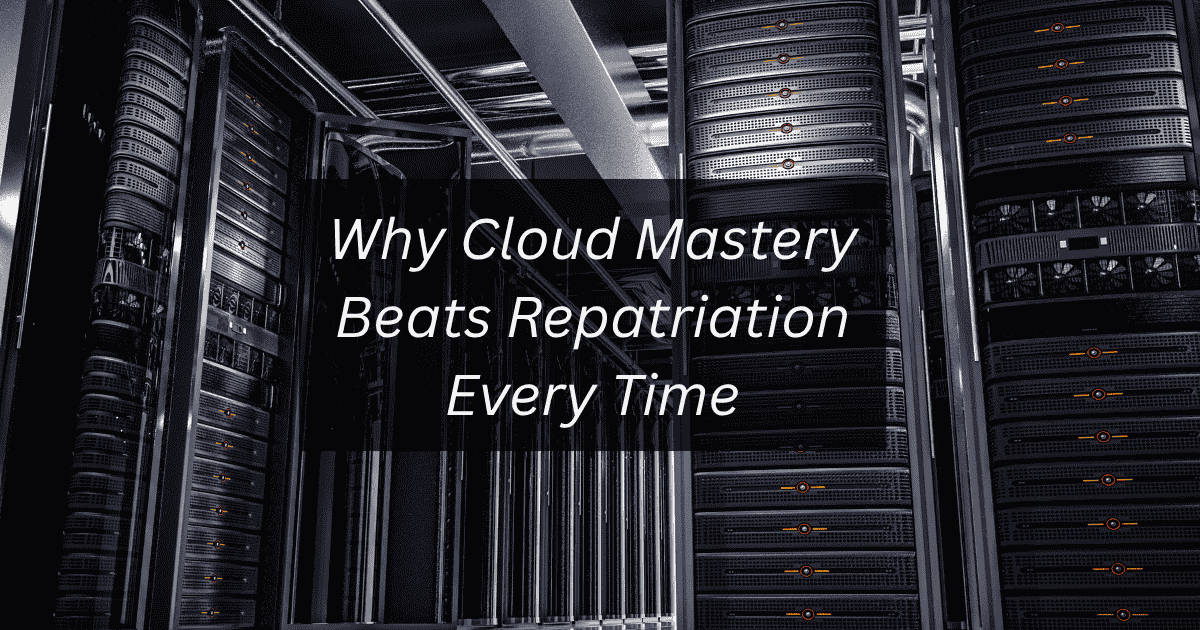Don't Retreat, Compete: Why Cloud Mastery Beats Repatriation Every Time
The financial pressure from your cloud spend is real, but repatriation is a permanent overcorrection for a solvable problem. The issue isn't the cloud; it's the absence of a mature cloud cost management strategy.

Is your CFO questioning a cloud bill that spirals higher each quarter? Before you consider the drastic step of cloud repatriation, understand this: bringing your workloads back on-premise isn't a cure. It's a costly reaction to a solvable problem. The real issue isn't the cloud; it's how you manage it.

Don't make this cloud repatriation mistake
Key Takeaways (TL;DR)
- The Problem: Many IT leaders are considering "cloud repatriation" due to rising and unexpected costs.
- The Flawed Solution: Repatriation often backfires, leading to massive new capital expenses, increased operational complexity, and a significant loss of agility and innovation.
- The Real Issue: Overspending is a management problem, with root causes in a lack of visibility, the absence of a FinOps culture, outdated mindsets, and a cloud skills gap.
- The Path Forward: The solution is a FinOps cloud operating model that doesn't sacrifice the strategic business value the cloud offers.
Table of Contents
- The Allure of Repatriation: A Flawed Solution
- Surface-Level Causes of Cloud Overspending
- The Deeper Problem: Root Causes of Overspending
- Beyond Cost: The Incalculable Value You Risk Losing
- Conclusion: Mastery, Not Retreat
- Frequently Asked Questions (FAQ)
The Allure of Repatriation: A Flawed Solution to a Real Problem
When your cloud bill feels like a runaway train, it’s tempting to pull the emergency brake and return to the familiar world of on-premise infrastructure.
Why "Bringing it Home" Seems Like the Obvious Answer
There’s a certain comfort in the old on-premise model. You bought servers, racked them, and knew your exact data center costs each month in a predictable Capital Expenditure (CapEx) model. The cloud’s variable Operational Expenditure (OpEx) model, while powerful, can feel unpredictable and opaque. When costs become unpredictable, the psychological appeal of owning and controlling your hardware is strong.
The Hidden Costs and Risks of De-Migration
Before you unwind your cloud migration, consider the full picture. Repatriation is a massive undertaking with often-underestimated costs and strategic risks.
- Massive Capital Outlay: Be prepared for significant upfront spending. You'll be procuring new hardware, securing data center space, and investing in all the networking gear required to connect it.
- Crippling Operational Overhead: Remember the maintenance, patching, and lifecycle management you offloaded to the cloud provider? That all comes back in-house, requiring you to hire or retrain staff to manage it.
- Loss of Agility & Innovation: This is the most critical loss. Repatriation sacrifices the ability to scale on demand, experiment with new services, and leverage powerful cloud-native tools for AI/ML. This loss of speed directly harms your competitive advantage.
- The "Boomerang" Effect: We’ve seen companies repatriate only to realize they’ve lost their competitive edge, forcing a costly and disruptive second migration back to the cloud.
Surface-Level Causes of Cloud Overspending
The following issues are the most common symptoms of a deeper problem.
- Symptom #1: Unused and "Zombie" Resources - The top cause of wasted spend is paying for resources you don’t use. This includes orphaned storage volumes, oversized server instances, and abandoned development environments—the digital equivalent of leaving the lights on in an empty skyscraper.
- Symptom #2: Suboptimal Pricing and Discounting - If you’re paying on-demand prices for steady-state workloads, you're leaving money on the table. Failing to use commitment-based discounts like Azure or AWS Savings Plans, Reserved Instances (RIs), or the Azure Hybrid Benefit for predictable workloads is a massive, unforced financial error.
- Symptom #3: Dependent Service Fee Surprises Did you budget for compute and storage? What about their dependencies, like data transfer, logging, metrics, and backup fees? These hidden costs can cause a nasty surprise on your final bill.

The Deeper Problem: Root Causes of Overspending
Fixing the symptoms above is like playing whack-a-mole. To create lasting change, you must address the root causes.
- Root Cause #1: Lack of Visibility and Accountability - You can't manage what you can't see. If your cloud bill is a single opaque number, you cannot enforce accountability. Without a robust resource tagging strategy and cost allocation dashboards, your teams are working in the dark.
- Root Cause #2: Absence of a FinOps Culture - This is the most important factor. FinOps is a cultural practice that brings financial accountability to the cloud's variable spend model by creating shared responsibility between Finance, Engineering, and the Business. When engineers can provision expensive resources with a single click but have zero visibility into the cost, overspending is inevitable.
- Root Cause #3: A Pervasive "Set It and Forget It" Mindset - Many teams treat the cloud like a traditional data center, provisioning for peak capacity for years to come. This is a cardinal sin in the cloud. The cloud model is dynamic; you must right-size instances, setup autoscaling, modernize applications, and optimize architectures.
- Root Cause #4: The Cloud Skills Gap - Your teams may lack the specialized skills needed to operate efficiently in the cloud. Cloud architecture, cost management, and automation are unique disciplines. Without this expertise, you’ll pay a premium for that skills gap every month.
- Root Cause #5: Service Model Complexity - With hundreds of services across multiple clouds, each with a unique pricing model, complexity is a major challenge.It is critical to understand the cost models for your most-used services and optimize their configurations accordingly.
Beyond Cost: The Incalculable Value You Risk Losing
Focusing only on the cloud bill is like judging a car by its monthly payment instead of where it can take you. A narrow, line-item focus on cost completely misses the bigger picture of the immense business value the cloud unlocks.
The true ROI of the cloud isn't found in a simple server-to-server cost comparison against your old on-premise model; it's measured in strategic gains that are difficult to quantify on a spreadsheet. Before making a decision based solely on expenditure, you must shift your perspective from "cost metrics" to "value metrics". This means connecting your cloud capabilities directly to revenue growth, market position, and operational resilience.
Before you consider repatriation and forfeit these advantages, ask yourself and your business leaders these critical questions:
- Speed to Market: How much revenue did you generate by launching a new product line three months faster than you could have on-premise? Think back to the old process: weeks or months spent on hardware procurement, shipping, racking, and configuration before a single line of code could be deployed. In the cloud, you can provision the necessary infrastructure in minutes.
- Resilience & Uptime: What is the real, bottom-line cost of an outage to your business, including lost revenue, customer support overhead, and damage to your brand's reputation? Now, consider how the ease of creating multi-site, high-availability architectures in the cloud has dramatically reduced that financial risk. The cloud democratizes enterprise-grade disaster recovery, making your services more durable and protecting your revenue streams.
- Innovation & Experimentation: How many new ideas, products, or features have your teams been able to test at a very low cost? This was often an impossibility in an on-premise world, where every new idea was gated by a six-figure hardware purchase order and the risk of that investment sitting idle if the project failed. The cloud fosters a culture of innovation by removing the financial friction of experimentation. This ability to "fail fast and cheap" is the engine of modern product development.
- Global Reach: How quickly were you able to expand your services into a new geographic market to serve a new customer base? The cloud allows you to deploy your applications close to your users anywhere in the world, reducing latency and improving their experience, much quicker than on premise, all without the massive capital investment and lead time previously required.
Conclusion: Mastery, Not Retreat
The financial pressure from your cloud spend is real, but repatriation is a permanent overcorrection for a solvable problem. The issue isn't the cloud; it's the absence of a mature cloud cost management strategy.
The path forward isn't retreat, but mastery. Don’t sacrifice the immense strategic value of the cloud to solve a problem that has a clear, attainable solution.
Stop Guessing, Start Optimizing.
Feeling the pressure of rising cloud costs? Crux Cloud Solutions specializes in diagnosing the root causes of overspending and implementing sustainable FinOps practices.
Let us show you how to optimize, not repatriate.
Schedule a Call TodayFrequently Asked Questions (FAQ)
What is cloud repatriation?
Cloud repatriation is the process of moving applications, data, and workloads from a public cloud environment back to a privately-owned, on-premise data center. It is often considered by companies experiencing high or unpredictable cloud costs.
What are the biggest hidden risks of cloud repatriation?
The primary risks are not just financial. They include: a massive upfront capital outlay for new hardware, a sudden increase in operational overhead for managing that hardware, and a significant loss of business agility and the ability to innovate quickly.
Why is a "FinOps culture" important for controlling cloud costs?
FinOps is a cultural practice that creates shared responsibility for cloud costs among finance, engineering, and business teams.It is critical because it closes the gap between a technical action (like launching a server) and its financial consequence, making cost-awareness a part of the development lifecycle and preventing overspending before it happens.
What are "zombie resources" in the cloud?
"Zombie" or "orphaned" resources are cloud assets that are still running and incurring costs but are no longer in active use.Common examples include storage volumes left over from deleted virtual machines or development environments that were abandoned after a project ended.They are a primary source of unnecessary cloud waste.



